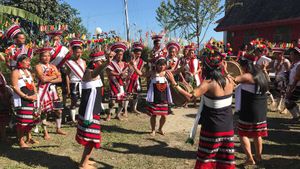The famous Hornbill festival of Nagaland gets its name from the endangered bird species - the Hornbill. The festival is a celebration of the varied tribal cultures existing in Nagaland. It includes everything from folk dances and songs to traditional games.
With its beginning in the year 2000, the Hornbill Festival will step into its 24th year this year, and people across the globe look forward to flying down to Kohima for the grand cultural show!
What is the Hornbill Festival?
A true face of the celebration of indigenous war tribes of Nagaland, the Hornbill Festival is a gala event depicting the rich and unique culture, heritage, and customs of the Nagas of North-East India. If you plan a trip to Nagaland, the Hornbill Festival must feature on your itinerary.
The Hornbill Festival is the perfect place to learn about the different cultural traditions, attires, legends, folklore, music, dance, and art forms of the many tribes and sub-tribes of Nagaland. A unique feature of this festival is that it is a true exhibit of the pristine customs and legacy of the place that the locals have successfully preserved, unaffected by the modernity of our world.
The festival borrows its name from the Hornbill bird, which was found in abundance in the region earlier but eventually became endangered. However, many of the tribal art forms depict the importance of the bird and encourage people to protect it.
Where is the Hornbill Festival held?
The Hornbill Festival is held at the Kisama Heritage Village every year. It is a small village of the Nagas, about 12 km (35-40 mins drive) from Kohima, the state capital. The festival premises are well-guarded and require the purchase of entry tickets. The grand event begins at 9 every morning, so it's better to head early to the venue and enjoy the scenic beauty of Nagaland along the way!
When is the Hornbill Festival held?
The Hornbill Festival is an annual event that usually happens in the first week of December (1-10 December). Often referred to as the ‘festival of festivals,’ the Hornbill festival is spread across ten days, where viewers get to witness the cultural grandeur of the Naga tribes through a display of their ethnic music, dance, art, handicraft, cuisine, and workshops.
What to do at the Hornbill Festival?
Organised by the State Tourism and Arts and Culture Department, Government of Nagaland, the Hornbill Festival is a fiesta promoting inter-tribal harmony and local culture and traditions. If you are at the Hornbill Festival, a lot of visual retreat awaits you.
You will witness the major tribes of Nagaland gather in large numbers to represent their folk dances, songs, art, and games. If you love exploring the food and craft of different places, then this festival is the earthly paradise for you. A rich display of locally produced handloom and handicraft products lights up the place, and you will surely find the perfect souvenirs and tribal food here! Different local food stalls selling multi-cuisine food options and stalls selling delectable rice beer are also available.
While the mornings at the festival are all about admiring folk culture, food, and handicrafts, the evenings are for the exciting Hornbill National Rock Concert! This rock concert attracts performers and bands across the country and the globe.
The hottest event at the Hornbill Festival is undoubtedly the Naga Chili Eating Competition. If you love spicy food, then you should consider participating in this fun and daring competition! There is also a Pork Eating Festival that people love. In totality, the Hornbill Festival is the perfect place to acquaint yourself with the customs of the 16 tribes of Nagaland attending the event. The scope of interacting with these tribal people and learning about their journeys is an exciting prospect in itself! Once you are done for the day at the festival, head over to the Night Market that lights up the nearby town and get yourself some nice souvenirs.
How to reach the Hornbill Festival venue?
You can take a flight to Dimapur from Kolkata or Guwahati and then reach the festival venue by road. Taxis ply on the Dimapur-Kohima route, and you can easily hire a cab, but if you are in a hurry, you may also opt for the 30-minute helicopter ride.
If you travel by train, Dimapur is the nearest railway station again. If you have the luxury of time and would love to travel cheaply, choose this route because the scenery will leave you mesmerised.
If you love to hit the road, then a car ride along the hilly terrains of North-East India won’t be a bad idea to reach the Hornbill Festival venue. Stick to NH39, which connects Kohima to Tripura, Arunachal, Meghalaya, Manipur, and Mizoram. The state highways merge into the Guwahati-Shillong road, and you can find plenty of local buses and cabs that take you to Kohima.
However, an important thing to remember is getting your Inner Line Permit. Visitors to Nagaland must get this ILP from the Office of Deputy Resident Commissioner in Guwahati, Shillong, Delhi, and Kolkata. You may also opt for an on-arrival ILP from the DC office of Dimapur. It is advised to apply for the ILP early in the morning so that you can have it by noon and then proceed to Kohima, which is just 2 hours away.
Where to stay if you are attending the Hornbill Festival?
It is better to take a hotel in Kohima and travel from there to the festival venue every day. You will find plenty of lodging options in Kohima - right from luxury to budget hotels and even camping options. The official Instagram page of the Hornbill Festival also features a list of hotel recommendations that you should consider while planning your trip!
What else to do in Nagaland?
Make the most of your visit to the Hornbill Festival by exploring nearby attractions. These include the Second World War Cemetery (Kohima), the Nagaland State Museum, the Catholic Cathedral, Naga Bazaar (renowned for the livestock trading market), and Khonoma Village. The famous trekkers’ paradise - Dzukou Valley, is just 20-22 km away from Kohima, and you can visit it as well. However, the hills and valleys are not as green in winter as in summer, but visiting this scenic paradise will still be worth the hassle!




